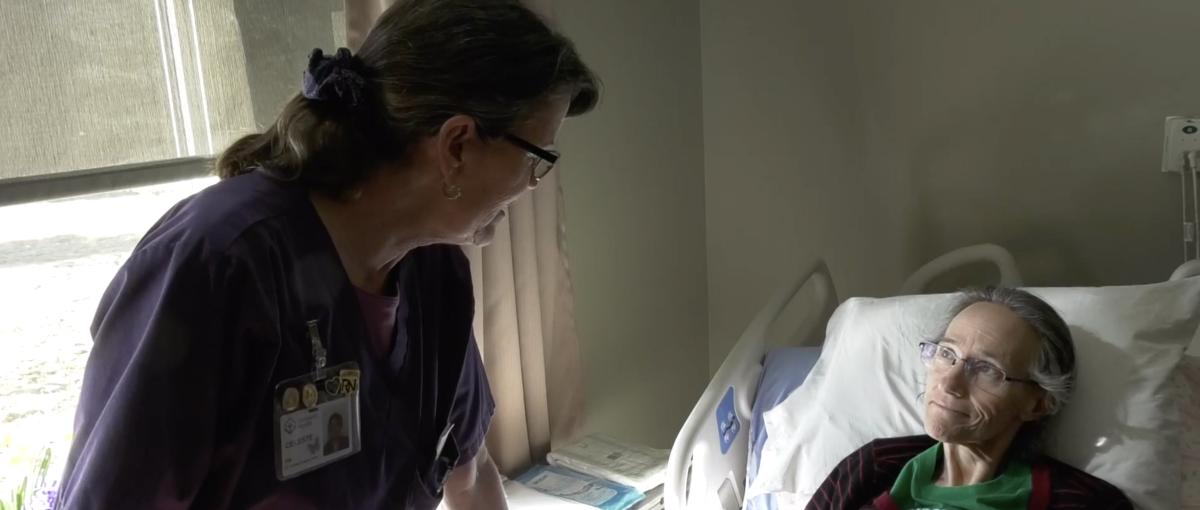What is palliative care
Palliative care helps people at all stages of a life-limiting illness

September 30, 2019
By Marguerite Watson, Senior Communications Advisor, Covenant Health
Palliative care can provide comfort for people, yet too few Canadians truly understand what it involves.
"We did a national survey [with Ipsos] a couple of years ago, and we found that only about half the Canadian population knows what palliative care is," says Carleen Brenneis, Director, Palliative Institute at Covenant Health.
"People don’t understand what the word palliative means, and if they've heard it, they sometimes associate it with the end of life and dying," says Karen Macmillan, Senior Operating Officer for the Grey Nuns Community Hospital and Senior Lead for Covenant's Palliative strategy.
While end-of-life care supports people through their final days, palliative care is available at any stage of a life-limiting or serious illness, from the first diagnosis to after death with bereavement support for the family, says Carleen. It's an approach to health care that focuses on providing comfort and improving quality of life for patients and their families. And people can receive it at any age and in any place — at home through home care, their family doctor and/or palliative care consultants; in the hospital; in a continuing care centre; or in a hospice at the end of life.
Good palliative care is holistic, says Karen. It involves treating the patient's physical symptoms as well as tending to their emotional, psychological and spiritual concerns. That requires individuals working together from different disciplines — health care, social work, spiritual care, occupational therapy, music therapy and so on — depending on the patient's and family's needs.
About 89 per cent of people who have a life-limiting illness, such as a progressive neurological disease or organ failure, could benefit from palliative care, according to the Canadian Hospice Palliative Care Association. Research has also shown that, along with enjoying better quality of life, people who receive palliative care tend to live slightly longer, Carleen says. And while comfort and quality of life are key benefits, including palliative care as part of primary health care, as it is in Alberta, also saves the system funding because people spend less time in hospitals and more time at home, in a hospice or in other settings.
No matter where a patient receives palliative care, it's their definition of comfort and quality that guides the support and care team planning. "You have to take the person where they're at and what comfort and quality of life mean to them," says Karen. "What they see as quality changes over time, and so it's a journey."
Encouraging people to talk about their values early in the journey is part of the work Karen, Carleen and other healthcare leaders are doing through a provincial initiative with Alberta Innovates, patients and families. They've just completed a five-year research project on how to get people interested in advance care planning. And new tools are available to help healthcare professionals have conversations with patients and families about serious illness and the patient's wishes for the end of life.
"The last thing we want to do is have conversations with someone who's imminently dying and try to figure out what's important to them," says Karen. "We want people to start talking about what quality of life looks like before they're ever diagnosed with anything or they're in a situation where their family needs to start making decisions."
Through their work with Palliative Care Matters — a national initiative involving patients, families and healthcare leaders — the Canadian Hospice Palliative Care Association and other groups, Carleen and Karen also hope to change public conversation about death and dying.
"If we could just bring death back into our lives a bit more, it would be easier to help people with it," says Carleen.
"People believe that dying is a horrible, painful process, and it doesn't have to be," says Karen. "When you take a palliative approach, you're walking with people, helping to address their symptoms and concerns."
Myths about palliative care
Palliative care is only for patients near the end of their lives
Palliative care benefits patients and families from the diagnosis of a life-limiting illness until the end of life.
Palliative care is only provided in a hospital
Palliative care can be provided wherever the patients lives – at home, in a long-term care facility, in a hospice or in a hospital.
Palliative care is only about pain control
Palliative care includes psychological, social, emotional, spiritual, caregiver and practical support.
Palliative care is for older people
Palliative care is provided to people of all ages, from infancy to adulthood.
Pain is part of dying
Pain is not always part of dying. There are many ways to alleviate pain for patients near the end of life.
Palliative care is only for people dying of cancer
Palliative care can benefit patients with any serious or chronic illness.
Sources: Canadian Hospice Palliative Care Association, 2019; Canadian Virtual Hospice, 2015